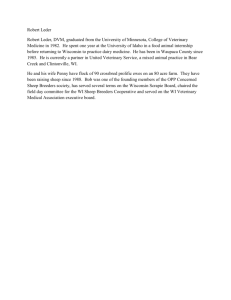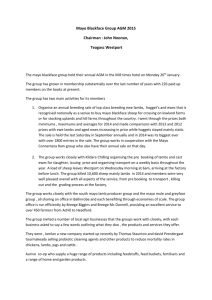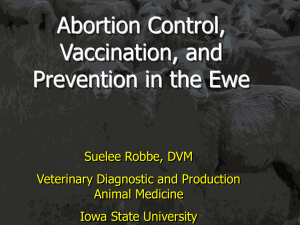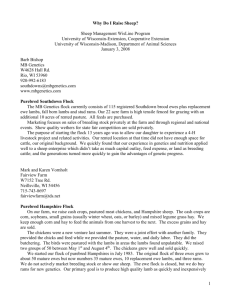summary document - The Canadian Sheep Federation
advertisement
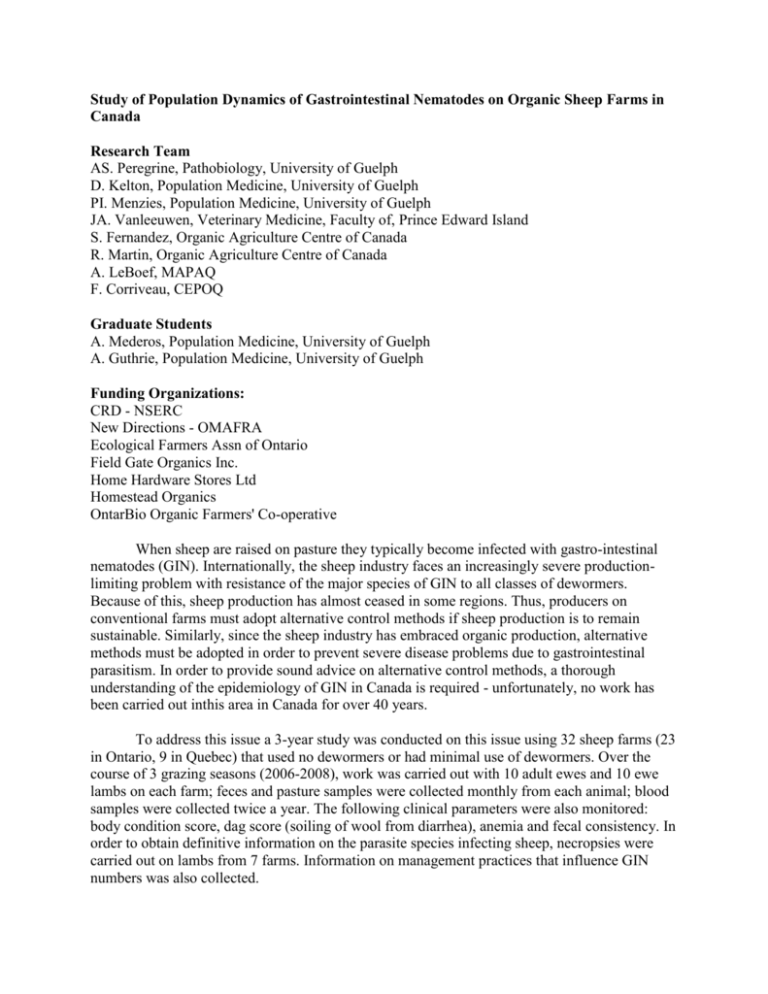
Study of Population Dynamics of Gastrointestinal Nematodes on Organic Sheep Farms in Canada Research Team AS. Peregrine, Pathobiology, University of Guelph D. Kelton, Population Medicine, University of Guelph PI. Menzies, Population Medicine, University of Guelph JA. Vanleeuwen, Veterinary Medicine, Faculty of, Prince Edward Island S. Fernandez, Organic Agriculture Centre of Canada R. Martin, Organic Agriculture Centre of Canada A. LeBoef, MAPAQ F. Corriveau, CEPOQ Graduate Students A. Mederos, Population Medicine, University of Guelph A. Guthrie, Population Medicine, University of Guelph Funding Organizations: CRD - NSERC New Directions - OMAFRA Ecological Farmers Assn of Ontario Field Gate Organics Inc. Home Hardware Stores Ltd Homestead Organics OntarBio Organic Farmers' Co-operative When sheep are raised on pasture they typically become infected with gastro-intestinal nematodes (GIN). Internationally, the sheep industry faces an increasingly severe productionlimiting problem with resistance of the major species of GIN to all classes of dewormers. Because of this, sheep production has almost ceased in some regions. Thus, producers on conventional farms must adopt alternative control methods if sheep production is to remain sustainable. Similarly, since the sheep industry has embraced organic production, alternative methods must be adopted in order to prevent severe disease problems due to gastrointestinal parasitism. In order to provide sound advice on alternative control methods, a thorough understanding of the epidemiology of GIN in Canada is required - unfortunately, no work has been carried out inthis area in Canada for over 40 years. To address this issue a 3-year study was conducted on this issue using 32 sheep farms (23 in Ontario, 9 in Quebec) that used no dewormers or had minimal use of dewormers. Over the course of 3 grazing seasons (2006-2008), work was carried out with 10 adult ewes and 10 ewe lambs on each farm; feces and pasture samples were collected monthly from each animal; blood samples were collected twice a year. The following clinical parameters were also monitored: body condition score, dag score (soiling of wool from diarrhea), anemia and fecal consistency. In order to obtain definitive information on the parasite species infecting sheep, necropsies were carried out on lambs from 7 farms. Information on management practices that influence GIN numbers was also collected. The most significant findings from the study were as follows: General Patterns of Infection: GIN were detected on all sheep farms throughout the study. However, among the farms there was large variation in the parasite burdens in sheep and on pasture. In general, the time of the year when fecal egg counts were at their highest differed between ewes and lambs: ewe counts peaked in spring (April-May), while lamb counts peaked during the summer (July-August). This indicated that ewes play a significant role in contaminating pasture at the beginning of the grazing season. As a result, ewes that lamb in the spring should receive preventive deworming at lambing; and lambs onsuch farms should be dewormed at 4 to 8 weeks of age. The results also indicate that annual monitoring of parasite egg output in sheep feces should be carried out in May for ewes and in July for lambs. Types of Gastrointestinal Parasites: The most common GIN species diagnosed by examination of fecal and pasture samples were Trichostrongylus spp, Teladorsagia circumcinta and Haemonchus contortus. Thus, information on parasite control in sheep from parts of the world where Haemonchus predominates (e.g. southern USA) is not necessarily applicable to Ontario and Quebec sheep producers. Risk Factors for Infection: Manure application on pasture during the previous year was shown to increase the risk of parasitism in sheep. Comparison of Canadian Data to the United Kingdom Model: Data from this study was used to generate a picture of the farm management practices, then modeled with computersoftware developed in the United Kingdom to determine the predicted level of parasitism in lambs over a season. The results of comparing model predictions to actual data showed that on most Ontario farms the values were generally very similar, and that the model was able to predict fecal egg counts reasonably well for the grazing seasons in 2006 and2007. Where the model did not make accurate predictions, it was determined that abnormalities in weather and extremedifferences in farm practices were the primary cause(s). Further work with this model should result in the development ofa parasite management tool for producers and their veterinarians. The benefit to society from this work will be reduced costs associated with sheep production from savings both on drugsand labor, improved productivity because of lower disease rates, a reduced risk of development of anthelminticresistance, improved welfare for sheep by disease avoidance, and application of sound science to sustainable productionof organic sheep.

